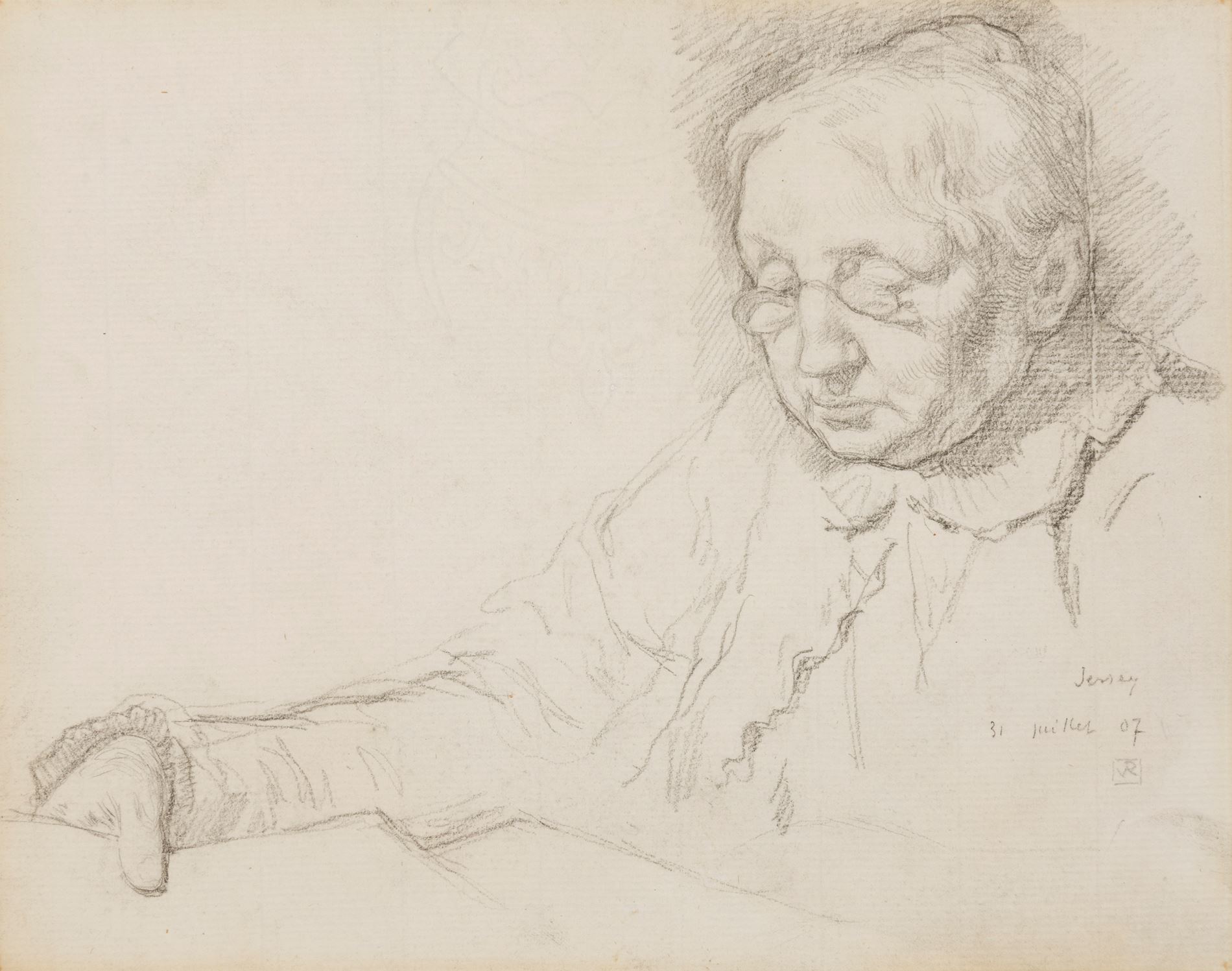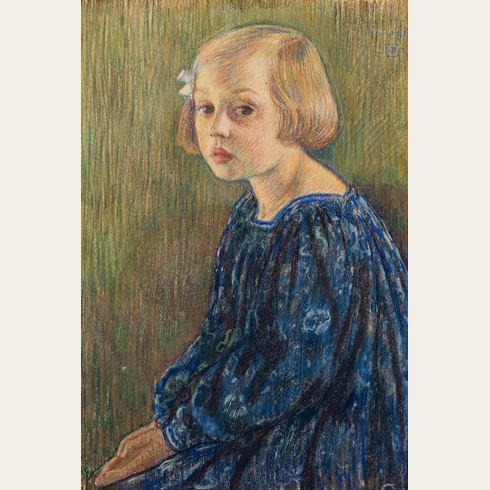Théo van RYSSELBERGHE
(Ghent 1862 - Saint-Clair 1926)
Portrait of the Artist’s Mother-in-Law, Mme. Sylvie Monnom-Descamps
Sold
Pencil on laid paper, laid down on board.
Inscribed and dated Jersey / 31 juillet 07 and signed with the artist’s monogram VR in pencil at the lower right.
Further inscribed Mme. Monnom in blue ink and Monnom / [?] in pencil on the reverse of the backing board
202 x 255 mm. (8 x 10 in.)
Inscribed and dated Jersey / 31 juillet 07 and signed with the artist’s monogram VR in pencil at the lower right.
Further inscribed Mme. Monnom in blue ink and Monnom / [?] in pencil on the reverse of the backing board
202 x 255 mm. (8 x 10 in.)
Théo Van Rysselberghe was a superb portraitist, and much of his early reputation was based on his portraiture, which also accounted for a large percentage of the works that he exhibited. While in the 1880s he produced mainly portraits of family and friends, by the following decade he was receiving numerous lucrative commissions for portraits, which earned the artist a tidy income.
In 1889 Van Rysselberghe married Maria Monnom, with whom he had his only child, Elisabeth. Both Maria and Elisabeth were to feature prominently in his work, as does Sylvie Monnom-Descamps (1836-1921), his mother-in-law and the subject of the present sheet. As one scholar has written, ‘The widow of Célestin Monnom, who died in 1871, the Veuve Monnom - as she was invariably called - was the powerful head of the Monnom publishing company…which issued the two leading avant-garde Belgian periodicals, L’Art moderneand La Jeune Belgique, and the catalogues and posters for the exhibition societies Les XX and La Libre Esthétique. She also supported progressive ideas by publishing many monographs…[and] further enriched the development of modern art in Belgium through her roles as patron and hostess.’ Sylvie Monnom owned paintings by Georges Seurat and Paul Signac, and hosted many artists and writers at her country home in Thuin in Belgium.
Van Rysselberghe painted at least six portraits of his mother-in-law, the earliest in 1887, before his marriage, and the last in 1919, two years before the sitter’s death at the age of ninety-five. As has been noted, ‘Van Rysselberghe’s mother-in-law provided the artist with a challenging subject as he captured her image throughout the last three decades of her eighty-five years in pencil, pastel, and oil.’ Among other portrait drawings of Mme. Monnom by Van Rysselberghe are three head studies, each datable to c.1900, in the Brooklyn Museum.
Drawn in 1907, this drawing is less formal and more intimate than others by Van Rysselberghe, and displays a different side of Mme. Monnom, who is captured in a quiet moment, reading a newspaper. The drawing is a preparatory study for a small, unfinished painting of Mme. Monnom Readingin a private collection in Paris, which, like the present sheet, was painted in Jersey in 1907.
A closely related pencil drawing of Sylvie Monnom reading, dated 27 July 1891 but more likely to be of the same date as the present sheet, is in a private collection.
In 1889 Van Rysselberghe married Maria Monnom, with whom he had his only child, Elisabeth. Both Maria and Elisabeth were to feature prominently in his work, as does Sylvie Monnom-Descamps (1836-1921), his mother-in-law and the subject of the present sheet. As one scholar has written, ‘The widow of Célestin Monnom, who died in 1871, the Veuve Monnom - as she was invariably called - was the powerful head of the Monnom publishing company…which issued the two leading avant-garde Belgian periodicals, L’Art moderneand La Jeune Belgique, and the catalogues and posters for the exhibition societies Les XX and La Libre Esthétique. She also supported progressive ideas by publishing many monographs…[and] further enriched the development of modern art in Belgium through her roles as patron and hostess.’ Sylvie Monnom owned paintings by Georges Seurat and Paul Signac, and hosted many artists and writers at her country home in Thuin in Belgium.
Van Rysselberghe painted at least six portraits of his mother-in-law, the earliest in 1887, before his marriage, and the last in 1919, two years before the sitter’s death at the age of ninety-five. As has been noted, ‘Van Rysselberghe’s mother-in-law provided the artist with a challenging subject as he captured her image throughout the last three decades of her eighty-five years in pencil, pastel, and oil.’ Among other portrait drawings of Mme. Monnom by Van Rysselberghe are three head studies, each datable to c.1900, in the Brooklyn Museum.
Drawn in 1907, this drawing is less formal and more intimate than others by Van Rysselberghe, and displays a different side of Mme. Monnom, who is captured in a quiet moment, reading a newspaper. The drawing is a preparatory study for a small, unfinished painting of Mme. Monnom Readingin a private collection in Paris, which, like the present sheet, was painted in Jersey in 1907.
A closely related pencil drawing of Sylvie Monnom reading, dated 27 July 1891 but more likely to be of the same date as the present sheet, is in a private collection.
A gifted painter and draughtsman, Theo van Rysselberghe studied at the Academy in his native Ghent and first exhibited his work in 1880 before completing his artistic training in Brussels, at the Académie Royale des Beaux-Arts, where he studied with Jean-François Portaels. He was a member of the Belgian artist’s society L’Essor and in 1883 was among the founder members of the more avant-garde group Les XX, who rejected academism and rebelled against the artistic standards of their time. It was through this artistic circle that Van Rysselberghe met such influential artists, including James Ensor, Fernand Khnopff and James McNeill Whistler.
A pivotal moment in Van Rysselberghe’s development as an artist came in 1886, at the eighth impressionist exhibition in Paris, where he encountered Georges Seurat’s monumental pointillist canvas A Sunday Afternoon on the Island of La Grande Jatte, painted between 1884 and 1886. This led Van Rysselberghe to experiment with the pointillist technique; and from 1886 onwards he was working in a Neo-Impressionist manner, becoming one of the leading exponents of pointillism in Belgium. In 1897 Van Rysselberghe left Brussels for Paris, where he worked on the anarchist journal Le Temps nouveaux, alongside other artists including Paul Signac, Maximilien Luce, Camille Pissarro and Kees Van Dongen. Regarded as the finest portrait painter among the Neo-Impressionists, he continued working in a pointillist manner until around 1907. Among his most significant later commissions was for an enormous painting to decorate a stair landing in the Hôtel Solvay on the Avenue Louise in Brussels, commissioned by the architect Victor Horta and completed and installed in 1902. A frequent visitor to the South of France, Van Rysselberghe settled permanently at Saint-Clair, near Le Lavandou, in 1911.
A pivotal moment in Van Rysselberghe’s development as an artist came in 1886, at the eighth impressionist exhibition in Paris, where he encountered Georges Seurat’s monumental pointillist canvas A Sunday Afternoon on the Island of La Grande Jatte, painted between 1884 and 1886. This led Van Rysselberghe to experiment with the pointillist technique; and from 1886 onwards he was working in a Neo-Impressionist manner, becoming one of the leading exponents of pointillism in Belgium. In 1897 Van Rysselberghe left Brussels for Paris, where he worked on the anarchist journal Le Temps nouveaux, alongside other artists including Paul Signac, Maximilien Luce, Camille Pissarro and Kees Van Dongen. Regarded as the finest portrait painter among the Neo-Impressionists, he continued working in a pointillist manner until around 1907. Among his most significant later commissions was for an enormous painting to decorate a stair landing in the Hôtel Solvay on the Avenue Louise in Brussels, commissioned by the architect Victor Horta and completed and installed in 1902. A frequent visitor to the South of France, Van Rysselberghe settled permanently at Saint-Clair, near Le Lavandou, in 1911.
Literature
Ronald Feltkamp, Théo Van Rysselberghe 1862-1926: Catalogue raisonné, Brussels, 2003, p.365, no.1907-019.
Exhibition
Brussels, Palais des Beaux-Arts, Exposition Centennale de l’Art Belge 1830-1930: Un siècle d’art, 1930 [not in catalogue].





